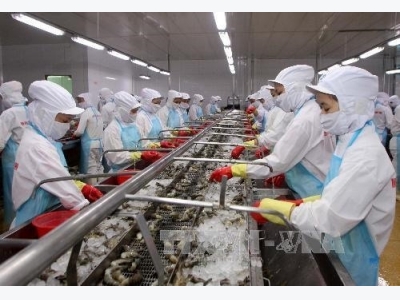Việt Nam shrimp exports remain buoyant

Workers at a shrimp processing plant. Việt Nam’s shrimp exports surged last year and good growth is also expected this year. — VNA/VNS Photo
Ho Chi Minh CITY — Shrimp exports increased sharply last year and the trend will continue this year, according to the Việt Nam Association of Seafood Exporters and Producers (VASEP).
The exports were worth an estimated US$3.8 billion last year, $700 million up from 2016 and $400 million higher than the association’s target.
There was big demand for shrimp in key markets such as the EU, China, Japan, and South Korea especially during the year-end festive season, VASEP said.
In the first 11 months of last year, the EU was the largest importer of Vietnamese shrimp, with shipments to the market going up by 42.4 per cent to $780 million and accounting for 22.2 per cent of Việt Nam’s exports.
Shrimp exports to China surged by 60.2 per cent to $637.9 million in the period, but shipments to the US fell by 7.8 per cent mainly due to high anti-dumping duties.
Trương Đình Hòe, VASEP’s general secretary, said the strong growth in shrimp exports last year was mainly thanks to better control of antibiotic usage in breeding the crustacean, an increase in exports of processed products, and buyers’ increased confidence in Vietnamese shrimp products.
In the EU, Vietnamese shrimp exporters enjoyed preferential treatment under the bloc’s Generalised System of Preferences while Thailand and China, the two main competitors, did not.
India’s shrimp exports to the EU were down because antibiotics were being frequently found in its products, and Indian companies faced the risk of bans, he said.
This meant European importers were looking for safer shrimp products, including from Việt Nam, he said.
The depreciation of the US dollar against the euro and yen had also supported Vietnamese exports, the association said.
Trần Văn Lĩnh, chairman of Thuận Phước Seafood and Trading Corporation, told Việt Nam News that an increase in the shrimp farming area, an improvement in farming technology and the quality of shrimp used for breeding, reduction in the use of antibiotics, and an expansion of eco-friendly farming had helped create reliable supply sources for processors besides helping them meet export standards.
“A number of Vietnamese shrimp processors have invested in producing value-added shrimp products, heralding a new export age.”
Last year his company earned $91 million from shrimp exports compared to $75 million in 2016, he said.
“Export volume went up by only 5 per cent last year, but thanks to an increase in export of value-added products, which accounted for 90 per cent of the exports, export revenues were up.
“Việt Nam has a good reputation for value-added shrimp products.”
Shrimp exports in 2018
This year his company would strive to maintain a strong foothold in its key markets, including the EU and Japan, Lĩnh said.
This year the market would be more favourable than 2017, he said.
“The Việt Nam-EU Free Trade Agreement, which is expected to come into effect this year, will help make Vietnamese shrimp more competitive than Thai and Indonesian, and Việt Nam’s shrimp exports to EU will be better this year.”
VASEP has also forecast that shrimp exports would rise strongly this year, especially to the EU, China, Japan, and South Korea.
China has high demand for seafood and its domestic output has reduced due to diseases and unfavourable weather.
Since December that country has cut import tariff on frozen shrimp from 5 per cent to 2 per cent.
These factors would boost Việt Nam’s shrimp exports to China, and the country could surpass Japan to become the second largest market.
But Lĩnh said currently shrimp exports to China were mainly in the form of border trade, with the key items being unprocessed products with low added value.
Vietnamese authorities should work with their Chinese counterparts to increase official shrimp exports and Vietnamese exporters should increase shipments of processed products to increase revenues, he said.
Despite many advantages, the shrimp industry could also encounter some challenges this year, including risks like unfavourable weather and diseases.
Hồ Quốc Lực, general director of Sao Ta Foods JSC, said “The biggest challenge to the industry is its small scale of farming, often making it difficult to trace product origin whereas import markets lay much emphasis on food safety and traceability of products.”
In this context, the industry needs to enhance quality control and build breeding areas of international standards to mitigate its weaknesses and boost exports this year, Lực added.
Related news
 Prices of tuna slump without being exported due to Covid-19
Prices of tuna slump without being exported due to Covid-19 Phú Yên’s farmers say that the price of ocean tuna is quite low. Once 130,000 dong/kg with tuna type 1, it is 100,000 dong/kg now.
 Pangasius exports “turn challenges into chance” amid Covid-19 pandemic
Pangasius exports “turn challenges into chance” amid Covid-19 pandemic The Pangasius sector has been badly impacted by the covid-19 pandemic and is implementing multiple synchronous solutions to overcome challenges.
 Imported lobster prices are likely at the bottom in Vietnam
Imported lobster prices are likely at the bottom in Vietnam Việt Nam is importing more and more goods from the US, especially with prices falling sharply as a result of that country’s trade war with China
 Pangasius output in March decreased nearly by 9% from the same period last year
Pangasius output in March decreased nearly by 9% from the same period last year Pangasius farming has been facing challenges without any sign of recovery and prices have stayed at the lowest level in the last ten years
 Mekong Delta: Prices of black tiger shrimps fluctuate wildly, inventory increases
Mekong Delta: Prices of black tiger shrimps fluctuate wildly, inventory increases Prices of shrimp material, especially black tiger shrimp, have been fluctuating wildly recently, resulting in hundreds of thousands of shrimp households